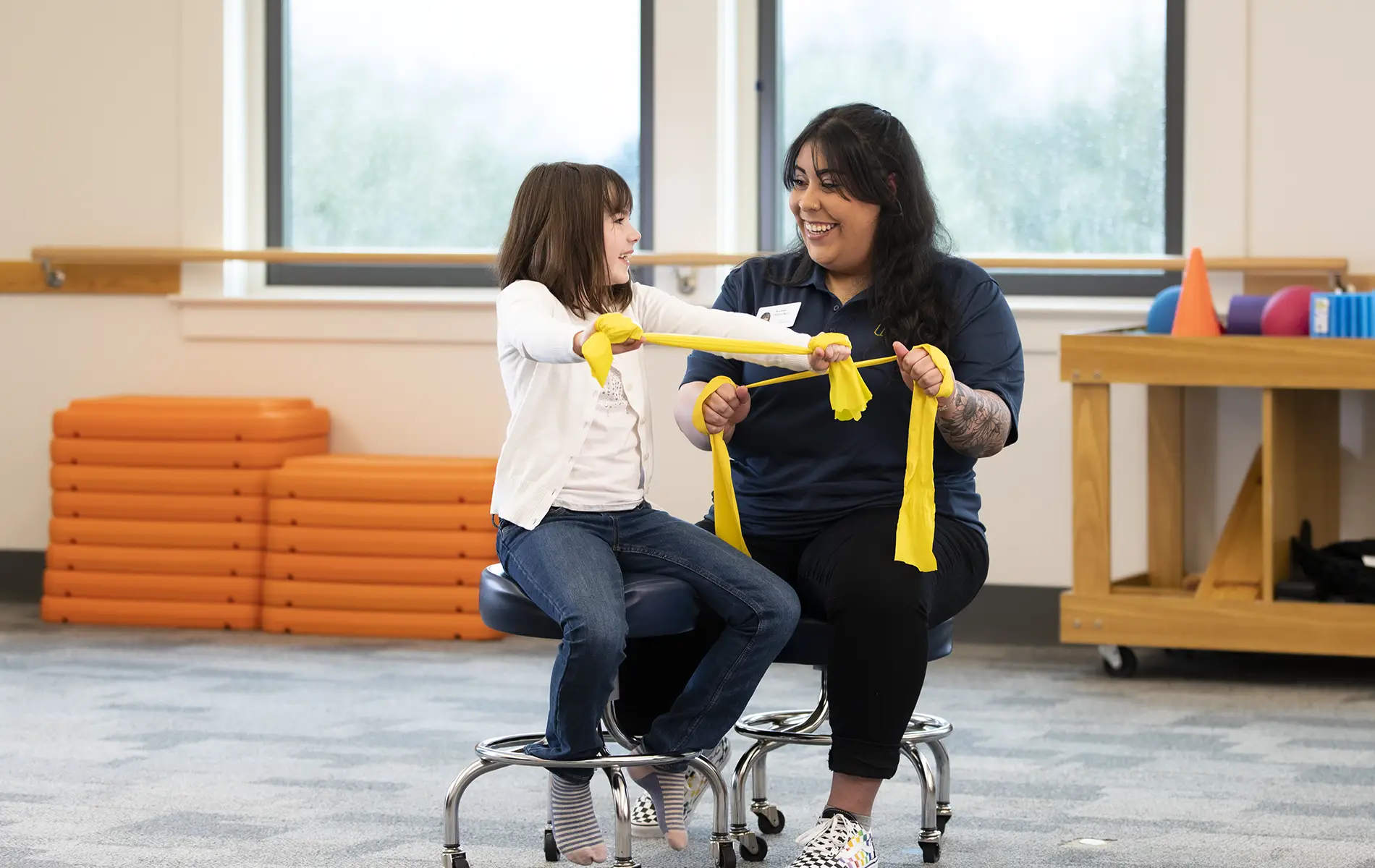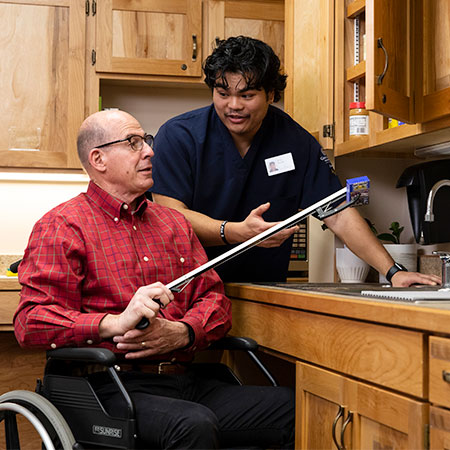
Occupational Therapist (OT) vs. Occupational Therapy Assistant (OTA)
by Stanley Paul, PhD, MD, OTR/L; and Trevor St. Clair, OTD, MS, OTR/L
It’s a term you’re most likely familiar with – “occupational therapist” – but there’s a good chance you actually don’t know what an “OT” does.
This article provides a comprehensive overview of the roles, education, and career prospects of occupational therapists (OTs) and occupational therapy assistants (OTAs) to help you decide which role is right for you.
Table of Contents
- What is an OT?
- What is an OTA?
- What is a COTA, and how does it differ from an OTA?
- What are the responsibilities of OTs and OTAs?
- What are their work settings?
- What are the education requirements for occupational therapy?
- How do you go from being an OTA to becoming an OT?
- How do the salaries of OTs and OTAs compare?
- What is the job outlook for occupational therapy?
What is an OT?
Occupational therapists (OTs) are healthcare professionals who evaluate and treat people who have injuries, illnesses or disabilities to help them with skills needed for work, daily life, and living as independently as possible.
This often includes helping people do meaningful everyday self-care tasks, often called “activities of daily living” or ADLs. Activities of daily living include bathing and showering, personal hygiene and grooming (brushing teeth, combing hair, etc.), dressing, functional mobility (such as getting out of bed), and feeding themself.
OTs have a broad scope of practice and can independently evaluate and plan interventions for individuals across the lifespan. They make clinical decisions, interpret evaluation results, provide treatment, and formulate discharge plans.
Examples of the work of an OT include:
- Developing motor-skills activities to help children reach developmental milestones such as crawling, walking, etc.
- Promoting health and wellness through community-based programming (e.g., educating families and civic groups on the benefits of an active lifestyle)
- Assessing hazards and identifying environmental factors that put senior citizens at risk in their homes or residential care facilities, for which they may recommend adaptive equipment (wheelchairs, walkers, etc.) if necessary
 It’s important that those being treated be involved in treatment planning so they are invested in their goals. For this reason, OTs use a client-centered approach to develop personalized treatment plans.
It’s important that those being treated be involved in treatment planning so they are invested in their goals. For this reason, OTs use a client-centered approach to develop personalized treatment plans.
Check out George Fox University's occupational therapy program
What is an OTA?
Occupational therapy assistants (OTAs) work under the supervision of OTs and assist with implementing treatment plans, but they cannot perform evaluations or interpret evaluation results independently.
These plans may include a wide array of treatment techniques, modifications to an individual’s environment, and training on use of adaptive equipment to become functionally independent.
OTAs are relied upon to gather information for the OT using observation and assessments. They also monitor an individual’s progress and inform the OT, making them a valued member of the occupational therapy team.
Note: Occupational therapy no longer trains OT aides, only occupational therapy assistants. Aides do not go to school to be specifically trained as OT assistants. They learn on the job and do not have a formal education to be occupational therapy clinicians.
What is a COTA, and how does it differ from an OTA?
Occupational therapy assistants must successfully pass their certification exam to practice. Once they pass this exam, they earn the right to add the “C” to their title, signifying that they are now a Certified Occupational Therapy Assistant (COTA). OTA and COTA are often used interchangeably to refer to these qualified professionals after passing the national certification exam.
COTAs work alongside occupational therapists in a variety of therapy settings and areas. They will commonly work with individuals who suffer from an illness, injury or a disability to improve and help them overcome the obstacles of daily activities. COTAs work with individuals across the lifespan, providing occupational therapy interventions to children, adults and the elderly.
What are the responsibilities of OTs and OTAs?
OTs and OTAs work together as a team to provide comprehensive care and help individuals achieve their goals. Here’s how their responsibilities compare:
Occupational Therapists
- Evaluate a person’s ability to perform activities of daily living (ADLs) and develop a comprehensive treatment plan
- Work with their client and their care team to set measurable goals and provide interventions to improve skills or make adaptations
- Have a high level of autonomy and can make independent clinical decisions, including modifying treatment plans based on the individual’s progress and changing needs
- Collaborate with a multidisciplinary team – including physicians, physical therapists, speech therapists, social workers, and the person's family – to provide holistic care and achieve optimal outcomes
Occupational Therapy Assistants
- Assist OTs in facilitating treatment sessions but cannot independently evaluate individuals
- Implement interventions as directed by the OT and provide support to help individuals achieve their goals
- Work under the supervision and guidance of OTs, following their directions and implementing interventions as prescribed
- Work as part of the treatment team, supporting the OT’s interventions and maintaining open communication with other healthcare professionals involved in the individual’s care
Where do they work?
OTs and OTAs work in the same settings, which include, but are not limited to:

- Hospitals
- Schools
- Skilled nursing facilities
- Pediatric clinics
- Assisted living facilities
- Rehabilitation centers
- Home health
- Community-based programs
- Mental health facilities.

What are the education requirements for occupational therapy?
OTs are required to have a doctorate (OTD) or master’s degree in occupational therapy (MOT) and must pass the National Board Certification of Occupational Therapy (NBCOT) Exam.
OTAs must have an associate degree or a bachelor degree in occupational therapy assistant and must also pass a national licensure examination. The associate’s degree is typically an associate of applied science (A.A.S.), while the bachelor's degree is commonly referred to as a Bachelor of Occupational Therapy Assistant (BOTA).
How do you go from being an OTA to becoming an OT?
An OTA would need to enter into and complete an accredited masters or doctorate entry-level occupational therapy program to become an OT. Having prior experience as an OTA before entering an OT program offers several benefits, one of which is the opportunity to work as needed during the program, such as on weekends, to reduce student loan debt. This advantage, along with the practical experience in the field, makes it a compelling choice for those considering the OT career path.
Among the benefits of earning a doctorate versus a master’s degree in the field are a pay increase and opportunities to do clinical research and work in higher education. Most academic programs require a doctorate for faculty positions, and a doctoral-trained OT has advanced research skills.
How do the salaries of OTs and OTAs compare?
According to the Bureau of Labor Statistics, the median annual wage for occupational therapists was $96,370 in May of 2023. The median wage is the wage at which half the workers in an occupation earned more than that amount and half earned less. The lowest 10% earned less than $65,210, and the highest 10% earned more than $129,620.
Meanwhile, the median annual wage for an occupational therapy assistant (OTA) was approximately $67,010. OTAs typically make an hourly wage between $28 and $38 per hour.
The tables below provide a breakdown of percentile wage estimates for both professions. On average, OTs make between 70% and 75% more than OTAs across the percentile spectrum.
Table 1: Percentile wage estimates for OTs
| Percentile | 10% | 25% | 50% | 75% | 90% |
|---|---|---|---|---|---|
| Hourly Wage | $31.35 | $38.12 | $46.33 | $52.64 | $62.32 |
| Annual Wage | $65,210 | $79,290 | $96,370 | $109,480 | $129,620 |
Note: Adapted from the BLS (2023)
Table 2: Percentile wage estimates for OTAs
| Percentile | 10% | 25% | 50% | 75% | 90% |
|---|---|---|---|---|---|
| Hourly Wage | $23.40 | $28.56 | $32.22 | $37.16 | $42.90 |
| Annual Wage | $48,670 | $59,400 | $67,010 | $77,290 | $89,230 |
Note: Adapted from the BLS (2023)
What is the job outlook for occupational therapy?
According to the U.S. Bureau of Labor Statistics, employment of occupational therapists is projected to grow 11% between 2023 and 2033, much faster than the average for all occupations.
About 9,800 openings for occupational therapists are projected each year, on average, over the decade. Many of those openings are expected to result from the need to replace workers who transfer to different occupations or exit the labor force, such as to retire.
Overall employment of occupational therapy assistants and aides is projected to grow 21% from 2023 to 2033. About 7,800 openings for occupational therapy assistants and aides are projected each year, on average, over the decade.
Learn more about George Fox University’s occupational therapy doctorate (OTD) program in Newberg, Oregon.